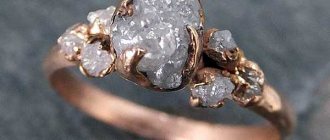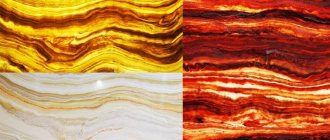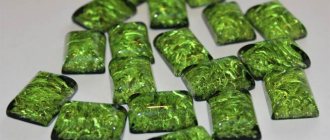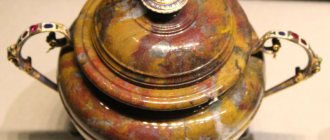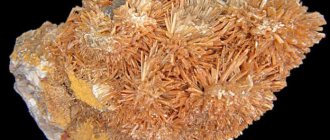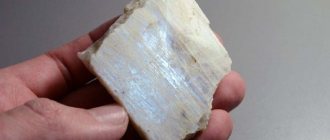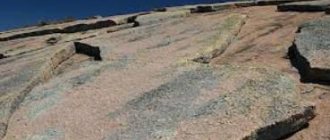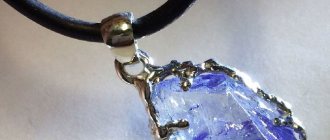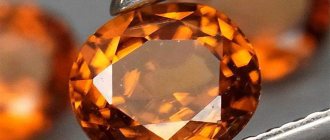What is quartzite
It is a metamorphic rock composed primarily of quartz, one of the most common minerals in the earth's crust. Quartzite was formed by metamorphism (structural change under high temperatures and pressure) from siliceous sediments. Most often, its formation is associated with the recrystallization of quartz sandstones or igneous rocks, such as porphyries.
The stone has a dense granular structure: microscopic grains of quartz merge into a solid mass with a splintered or conchoidal fracture. When fractured, the stone has a typical quartz luster. According to the classification of M. Bauer, the rock belongs to semi-precious ornamental stones - this order also includes malachite, jasper and jade. Basic shades: white, gray, red. In nature, quartzites are also found in other colors: light yellow, brown, blue.
Many varieties of quartzite are valuable minerals. Ferrous (magnetite) quartzites are the most important iron ore. A special variety is secondary quartzite. Deposits of secondary quartzites are formed as a result of relatively low-temperature metasomatic transformation of acidic and intermediate effusive, less often intrusive acidic rocks and their tuffs. Deposits of gold, copper, molybdenum, polymetals and pyrites are associated with secondary quartzites.
In our country, the most valuable and beautiful variety is crimson Shoksha quartzite; quartzite is mined on the western shore of Lake Onega in Karelia.
Description and history of quartzite
Quartzite is formed from sandstone containing quartz as its main component. At high pressure and temperature, mica, spar, talc and other igneous rocks are added to the sandstone. This makes the combination fireproof and extremely durable.
Primitive household items of ancient people are made of quartzite. Later, the mineral was used by architects to build the following masterpieces:
- Sarcophagus of Napoleon;
- Roof of the Mausoleum;
- Tomb of Tsar Alexander II;
- The cladding of a majestic building in St. Petersburg - the Cathedral of the Resurrection of Christ on Spilled Blood.
Properties of quartzite
- High hardness. On the Mohs scale, quartzite has a rating of 7, which corresponds to the hardness of quartz. The mineral can be processed with diamond and scratches glass. Such hardness sharply limits the possibilities of stone processing. This feature affects the final cost of facing materials.
- High density. The average density of quartzite is 2700 kg/m³. For comparison, the density of granite is 2600 kg/m³, the density of sandstone is 2250 kg/m³. The higher this indicator, the heavier the stone.
- Fire resistance. Structural changes in stone begin at temperatures above 1700°C, which makes it an excellent raw material for the manufacture of refractory materials. For example, ordinary clay brick can withstand temperatures of 1350°C, fireclay - 1580°C.
- High compressive strength – up to 450 MPa. According to this indicator, some types of quartzite are superior to granite and comparable to steel. Artificial building materials are not able to compete in this regard at all. Thus, heavy concrete of class B22.5 has a compressive strength of only 30 MPa.
- Durability. The first signs of stone crumbling appear after 250-300 years. This is facilitated by the good frost resistance of the mineral and its resistance to alkaline and acidic environments. Unlike marble, this stone does not react to hydrochloric acid.
- Low radioactivity. Quartzite belongs to class 1 building materials, that is, it can be used in the construction of public and residential buildings.
Healing and magical properties of the stone
The mineral has a healing effect on the human body and helps identify problems at the onset of their occurrence. Maintaining a constant temperature, retaining heat, quartzite:
- speeds up recovery;
- strengthens the immune system;
- relieves muscle pain;
- stimulates metabolism.
Attention! Elderly people are advised to wear rock jewelry. The mineral has a beneficial effect on the heart and prevents the development of joint pathologies.
A detailed description of the characteristics allows you to understand why quartzite exhibits magical properties. The mineral gives men:
- endurance;
- justice;
- courage.
The gem protects women from rudeness and violence, helps raise self-esteem, and gain respect among those around them. People who do not take their promises seriously are not advised to purchase quartzite products.
Composition of quartzite. Minerals
The mineral composition of quartzite is predominantly quartz (quartz content in the rock reaches 88-98%), containing iron hydroxides (2-3%), silicon and chalcedony (4-5%). The stone also contains impurities of mica, talc, feldspar and other minerals. Quartzite is named according to its mineral composition (for example, kyanite, magnetite), and the proportion of the word-forming mineral must be at least 5%.
Separately, secondary quartzites are distinguished with the inclusion of sericite, alunite, corundum, topaz and other minerals. These are metasomatic rocks in which the primary composition has changed significantly as a result of reactions between minerals and solutions through which the rock is deposited.
Quartzite mining
The main deposits of the mineral are located in Russia (Karelia), Ukraine (Krivoy Rog), and the USA (Lake Superior). Like any other natural stone, quartzite is mined using a quarry method. There are three ways to mine stone:
- Explosive. Holes 10-20 m deep are drilled into the solid layer of rock, and explosives and detonators are placed in them. Several dozen wells are used to undermine the formation. This is the cheapest method, leaving a large amount of waste, and is relevant when crushed stone is needed for construction work.
- Air cushion method. Holes are drilled in the mining area and filled with air under pressure. As a result, a fault is formed, breaking off the block from the main massif. The method does not lead to the formation of microcracks and is generally more gentle compared to explosive.
- Stone-cutting. Blocks of quartzite are cut out of the formation using rope stone-cutting machines. For this purpose, special diamond-coated cables are used. The resulting blocks are removed from the mining area by heavy cranes.
After extraction, the resulting material is sorted, crushed or sawed into slabs in a specialized workshop.
Kinds
Depending on the color range, quartzite is divided into three types:
White . This stone is not pure white; it can be found with admixtures of other rocks. The scope of its application is architecture and sculpture: monuments and memorials, complex and simple sculptures, statues, columns.
Raspberry . One of the most beautiful of its species, but rare. There are several subspecies of this stone: fiery red, dark red and soft pink, as well as their various shades. It is very popular and common in China. Most of the temples and statues are built from this beautiful rock.
Grey . The most common. It is not just gray in color, but a pleasantly warm silver.
Use of quartzite
- Road and capital construction. Crushed stone from low-grade quartzite is used to form concrete mixtures and as a cushion in the construction of foundations, supports, and laying asphalt.
- Metallurgy. The mineral is used as a flux that lowers the melting point of metals. Crushed crushed stone is used as an additive, with the help of which the slag is separated from the metal melt.
- Production of refractory materials. Crystalline quartzite is used in the manufacture of silica refractory bricks for laying heating furnaces. Dinas quartzite contains 96-99% SiO² with a minimum amount of alumina and alkalis.
- Bath stone. Rolled quartzite, especially crimson, is used to organize heaters in baths. Large fractions of stone are placed in the lower part of the heater, and small fractions are placed in the upper part.
- Interior design. Quartzite is widely used for finishing floors, window sills, sinks, and stairs.
- Facing. Due to its good frost resistance and resistance to aggressive environments, this mineral is suitable for exterior decoration of buildings, arrangement of gazebos and fountains. It is often used to design garden landscapes, recreation areas, and house terraces.
Popular types of natural quartz stones for sauna
Today, the most common natural quartzite is available in two shades. Minerals are great for a variety of purposes, but are most often used to create a gentle, healing steam. .
Quartzites of white and pink shades can most often be found in heater stoves
White quartz
Light quartzite is best suited for a bathhouse. Among its advantages we can highlight the excellent:
- Strength.
- Heat resistance.
- Heat capacity.
The main distinguishing feature of the quartzite rock is its ability to release oxygen. Thanks to this, the blood is saturated with O2 and brain function is stimulated, and a person’s well-being improves.
When heated, the crystals release ozone, which rejuvenates and cleanses the skin, making it rested and healthy.
Quartzite in the interior
Quartzite is an excellent material for creating sophisticated interiors. This stone is perfectly polished and polished - polished slabs are used for cladding walls, floors, fireplaces, making stairs, kitchen and bar counters. Of particular value is the crushed mineral with the texture of a “rock” - it imitates the structure of untreated stone with splits. There are three main colors of quartzite:
- White or white-yellow. The most popular type with a varied texture, gray or black inclusions in the form of spots and stripes.
- Grey. It features an impressive silver-gray surface.
- Raspberry or pink. Relevant for the manufacture of statues and other small and large architectural forms. Suitable for creating ornaments.
Quartzite goes well with other natural and artificial finishing materials. This mineral looks especially impressive in combination with marble, sandstone or granite.
Go to the quartzite catalog.
Types of metal
To establish the types of this mineral, you first need to take into account its color. Other features are quite difficult to distinguish without special devices. Types of metal:
- White or pale yellow . This shade is the most common among all. Typically, stones of pale shades contain impurities from other types of minerals, which can be found both inside the stone and on its surface; usually they are not ordered and are located chaotically. In most cases, this coloring of stones is used in finishing building materials and design.
- Raspberry . A striking feature of this variety is the presence of rich colors in red shades: hot pink, brown, purple, crimson. This quartzite is popular in the manufacture of monuments, statues, and monuments, and is also often used in the decoration of landscape decorations associated with design solutions.
- Grey . This color range features a beautiful silver-colored surface that can easily fit into almost any interior with light tones. It is often used in decorative solutions, landscape designs and the production of building materials.
